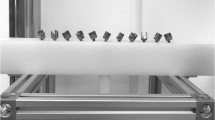Abstract
Spinal implants retrieved from 11 patients with scoliosis were examined. All the implants were posterior instrumentation systems made of 316L stainless steel and composed of rods, hooks, and crosslink connectors. Corrosion was classified into grades 0 to 3 based on macroscopic findings of the rod surface at the junction of each hook or crosslink connector. Grade 0 was defined as no sign of corrosion, grade 1 as surface discoloration, grade 2 as superficial metal loss, and grade 3 as severe metal loss. The depths and characteristics of metal loss areas were examined. Spinal implants showed more corrosion after long-term implantation than after short-term implantation. Corrosion was seen on many of the rod junctions (66.2%) after long-term implantation, but there was no difference between the junction at the hook and those at the crosslink connector. It is thought that intergranular corrosion and fretting contributed to the corrosion of implants. The current study demonstrated that corrosion takes place at many of the rod junctions in long-term implantation. We recommend removal of the spinal implants after solid bony union.
Similar content being viewed by others
Author information
Authors and Affiliations
About this article
Cite this article
Akazawa, T., Minami, S., Takahashi, K. et al. Corrosion of spinal implants retrieved from patients with scoliosis. J Orthop Sci 10, 200–205 (2005). https://doi.org/10.1007/s00776-004-0867-3
Received:
Accepted:
Issue Date:
DOI: https://doi.org/10.1007/s00776-004-0867-3




